![]()
Plant Dreams, Grow Gardens
Greenhouse provides the capability of growing tomatoes and other fresh vegetables all year round. Commercial Greenhouse gardeners are utilizing the amazing greenhouse technology and are producing fresh tomatoes during the early spring and late autumn when growing tomatoes was just a dream.
Unlock the potential of your garden with GreenhousePlanter – explore our PRODUCTS today!

But! can a beginner greenhouse hobbyist grow Greenhouse Tomatoes ?
“It’s difficult to think anything but pleasant thoughts while eating a homegrown tomato.”
Lewis Grizzard
A big Yes! Growing Greenhouse Tomatoes is not as hard as it sounds. At the same time, it is not an easy task either. You need to have the necessary information on how to grow Greenhouse Tomatoes.
If you don’t know how to grow Greenhouse Tomatoes; Don’t you worry! I have prepared this extensive guide that will explain everything on growing Greenhouse Tomatoes.
I have spent 3 weeks, writing this article and I have made sure that I have covered each and everything related to Greenhouse Tomatoes. If you still have some concerns feel free to ask it in the comments section below.
In order to grow tomatoes in your Greenhouse, You should first have your greenhouse ready. If you don’t own a greenhouse yet then don’t worry, I have written a complete detailed article on “How to Build a Greenhouse” that will help you build your own Greenhouse.
Note: The info provided in this article are taken for academic publications. Therefore, feel confident in following this article. It would be awesome if you share this information with your friends as a token of appreciation for the hard work I have put in this article
In Today’s blog, I will try my level best to enlighten you with the knowledge on how to grow Greenhouse Tomatoes which will include: selecting tomato varieties, Growing times (sowing tomato seeds and transplanting tomato seedlings), how to start with tomato seeds, transplanting tomatoes inside your greenhouse, plant spacing, temperature, and humidity requirements, Greenhouse Tomatoes Pests and diseases and many more.
Before we get into the details of growing Greenhouse Tomatoes. You should consider these important points.
These points that I have mentioned above are not meant to discourage you. I want you to take the task of growing tomatoes inside your greenhouse as a challenge and believe me its a fairly easy challenge. You should definitely take the task of growing Greenhouse Tomatoes.
I just want you to follow the guidelines that I have prepared for you in this article and if you follow them I am very confident that you will be successful in growing your Greenhouse Tomatoes.
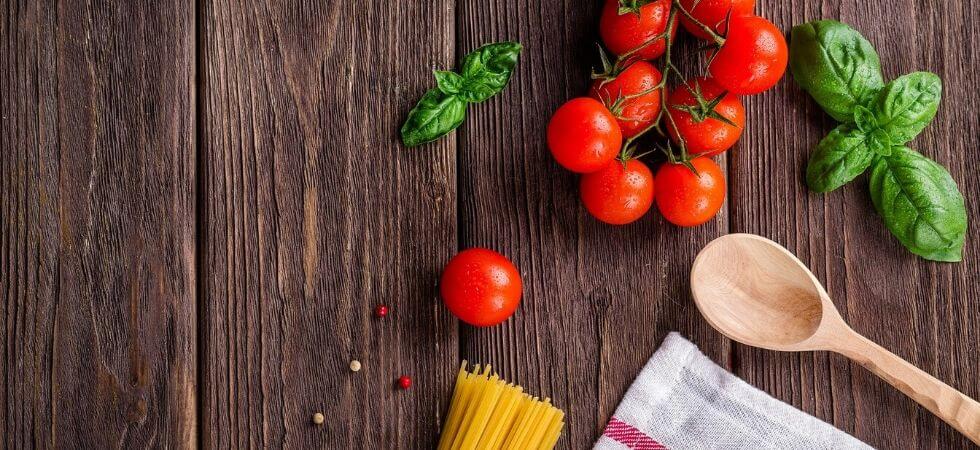
(I am sharing more tips and points on successfully growing your Greenhouse Tomatoes if you want to get straight into the procedure skip this part. But, I highly recommend you to keep on reading)
We all know that humans learn from their mistakes. You might have the same strategy in mind for planting your Greenhouse Tomatoes. But the problem is you will waste a lot of time and effort if you just dive into growing tomatoes without proper information.
I am here to provide you as much information as I can so you can successfully grow your Greenhouse Tomatoes. I may not be able to cover everything, so you can ask your concerns and questions in the comment section. Furthermore, I will also recommend you getting in touch with other greenhouse growers on various online forms and asking their recommendations.
For successfully growing tomatoes inside your greenhouse, you should follow these guidelines.
I hope you are learning a lot from this article, In the meantime, you can subscribe to our newsletter so you don’t miss out on our upcoming articles.
If you want to grow tomatoes inside your greenhouse, You should ensure that your greenhouse is located on a site that gets full sunlight (which is not shaded by any other tree or object around your greenhouse) at least for 6 hours. Furthermore, your greenhouse should be on elevated ground and it should have good air movement.
If you want to grow your greenhouse tomatoes in soil then the location which you have chosen should have fertile soil and it should not have any previous history of diseases. If the soil is not fertile then I would recommend growing in raised beds with topsoil and organic compost mix (use vermicompost or cow manure compost or chicken manure compost with normal leaf compost).
I personally prefer growing in raised beds because it has a lot of advantages which I will mention in one of the upcoming article.
If you have dedicated your entire greenhouse for growing tomatoes or you have dedicated an entire row from one end to the other end of your greenhouse, then I would strongly recommend installing a drip irrigation system for your greenhouse tomatoes as it will save you a lot of time and labor. More info is provided in the irrigation section below.
The first step for successfully growing Greenhouse Tomatoes is the selection of tomatoes varieties that are recommended for growing inside greenhouses. If you are a commercial grower, then you should also consider the size, shape, and color of the tomatoes which has a good demand in the market and it should also produce a high number of fruits per plant which is very important to run a profitable operation.
Hybrid seeds usually provide better yield and good fruit size. No doubt, hybrid seeds have high costs, Yet it is the least expensive cost involved in growing tomatoes in Greenhouse. So, you should never look for low-cost seeds, because with lower cost the quality of the seeds is also low and it will not produce a good amount of fruits per plants, Therefore, you should always look for high-quality seeds.
There are a lot of tomatoes varieties but a few varieties are recommended for growing in greenhouses. Yet, if you are not growing for market, I would recommend experimenting with many varieties as you can, because your goal is to get good quality and flavored tomatoes for your home consumption. However, if you are planning to grow commercial then only go with the recommended tomatoes varieties.
Whenever you are selecting tomatoes for your greenhouse. You should select the variety which has the following characteristics.
These characteristics are very important for commercial tomatoes production. However, if you are growing tomatoes for your home consumption, you should go with tomatoes varieties that taste better and produces favorable quantity of fruit.
If you buy seeds in large amounts then it will cost lower, However, you should never buy seeds more than you need. You should always plant a few seeds extra because you will never get 100% germination. Tomato seeds are very small in size. One-fifth of 1 ounce (5.7 grams) contains about 1200 seeds.
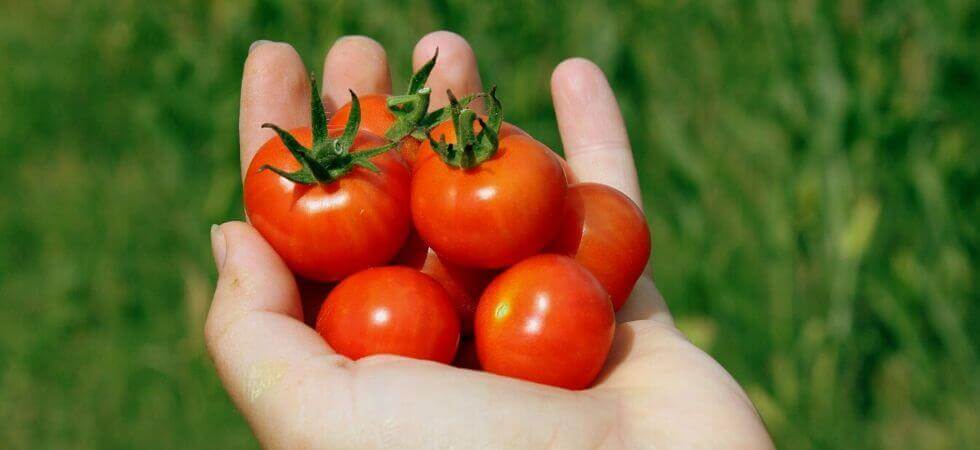
I think we should discuss the different types of tomatoes, I feel that it should be discussed by now!
Tomatoes are grouped into two categories according to their growth habits. Determinate tomatoes and Indeterminate tomatoes; former ones grow to a pre-determined height ( It stops growing at height of 4 to 5 feet). While indeterminate tomato growth does not stop. This is because the terminal of the stem of indeterminate tomato plants continues to grow. These are most favored among the two types of tomato varieties and it gives fruit throughout the season.
Determinate Greenhouse Tomatoes produces a large quantity of fruit and the harvesting duration is only a couple of months, whereas, indeterminate Greenhouse Tomatoes will give small quantity fruit but keeps on producing for a longer period of time.
Now! you need to choose which type of tomatoes you want for your greenhouse (Either determinate or indeterminate). You can select based on your preference, your greenhouse height, length of the fruiting period ( indeterminate tomatoes produce fruit all year round whereas the fruiting period of determinate tomatoes is just a couple of months), and the amount of time labor you want to spend for your greenhouse tomatoes (as indeterminate tomatoes require regular pruning, so more labor-intensive).
If you want to grow Greenhouse Tomatoes as a hobby then I will recommend you to try both determinate and indeterminate tomato varieties. Some of the recommended tomato varieties that grow well in the greenhouse and which are also disease resistant are (Especially for Commercial Greenhouse Growers):
Serious Commercial greenhouse growers should not grow outdoor varieties such as Celebrity, Better Boy, Travelers, etc., in the greenhouse. However, you should definitely give it a try if you are a hobbyist greenhouse grower. For determinate tomato varieties, you should try the famous tomato varieties like “Celebrity,” “Mountain Fresh”, and “Mountain Pride”. For indeterminate type, you can try growing “Better Boy” and “Fantastic”.
Here is a chart of popular tomato varieties that you can grow in your Greenhouse based on your choice.
| Cherry Tomatoes | Plum Tomatoes | Heirloom Tomatoes | Medium (‘Normal’) Tomatoes | Beefsteak Tomatoes |
| Tomato Gardener’s Delight | Tomato ‘il San Marzano Lungo | Tomato Brandywine | Tomato Ferline | Tomato Super Marmande |
| Tomato Gartenperle | Tomato Roma VF | Tomato Craigella | Tomato Cristal | Tomato Country taste |
| Tomato Maskotka | Tomato Falcorosso | Tomato Yellow Stuffer | Tomato Tamina | Tomato Cuore di Bue |
| Tomato Losetto | Tomato Principe Borghese | Tomato Black Russian | Tomato Orkado | Tomato Striped Stuffer |
| Tomato Suncherry Premium | Tomato Roma Nano | Tomato The Amateur | Tomato Alicante | Tomato Big Daddy |
There are two methods of growing tomatoes inside greenhouse. These are either soil or soilless cultures.
In soil cultures, tomatoes are grown in a plot of soil inside the greenhouse. The techniques for growing tomatoes inside the soil is similar to that of the tomatoes growing in the fields. Most of the Greenhouse growers (including me) grow tomatoes in a raised bed and I would definitely recommend if you want to grow soil cultures.
On the other hand, plants grown in soilless tomato culture are grown in water, woodbark, sand, or artificial soil mix, and the nutrients (fertilizer) are provided to the tomato plants in water solution.
Disease Control in the soilless systems is a big advantage but these systems are more costly and complex to maintain as compared to the soil cultures. So, if you are a new greenhouse enthusiast, I would strongly recommend going your greenhouse tomatoes in soil.
For Commercial greenhouse growers, soil culture has proven to the most effective, this is because the initial cost for the soilless system is very high. The overall greenhouse setup construction with soil is one third to one-fourth of the soilless system.
Another drawback of the soilless system is that if you are installing a large system then you will not be able to move it to another location. On the contrary, greenhouses, where the tomatoes are grown in soil, can be easily moved to another location if required.
However, some of the soilless systems use “grow bags” with compost media which is much cheaper than the floating systems (hydroponics). The water dissolved nutrients are supplied to the tomatoes using a drip system and they can also be moved comparatively easy.
Using the correct plant density is very important for the proper growth and good produce of each individual plant. You should give at least 4 square feet for each individual plant (10000 tomatoes plants per acre).
Recent research has found that a plant density of 5 square feet per plant produces the same. You can see how important it is to give every individual tomato plant the space it needs.
If you want to have your entire greenhouse for growing tomatoes then you might be interested in determining how many tomatoes plants you can grow inside your greenhouse.
You should first find the total area of your greenhouse (or Greenhouse tomatoes raised bed if you are growing in just one raised bed ) by multiplying the length and width of your greenhouse and then dividing by 4 or 5 if you want your tomatoes plants to occupy an area of 4 feet square or 5 feet square. If you have planned to spare some space for other purposes (such as pathways, storage, packing, etc). Subtract this area from the total area of the greenhouse and then divide by 4 or 5.
This illustration will below give you a clear idea of how you can plant your greenhouse tomatoes. The tomatoes are separated by a distance of 2 feet and each individual tomato covers an area of 4 square feet (2 feet length and 2 feet wide).
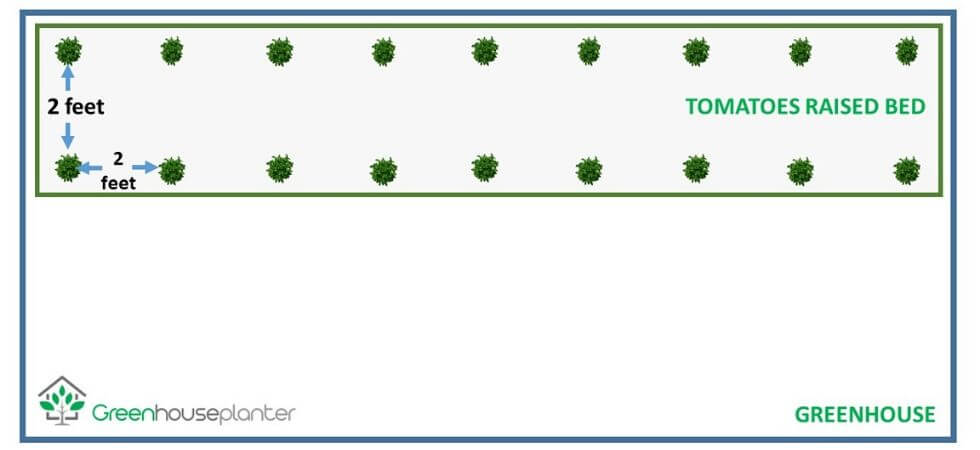
Keep in mind that, if you increase the planting density (give each plant less space than 4 square feet), then the yield per plant will decrease and the overall yield of your greenhouse will almost remain the same. This is because the greenhouse tomato plants will shade one and other, therefore the yield per plant will decrease accordingly. (source: UMass Amherst https://ag.umass.edu/).
Increasing the plant’s density of the greenhouse is not a great idea, it will encourage more disease because the think foliage will not dry quickly and it will also increase the cost and the amount of labor required.
For commercial greenhouse growers, there are two principal cropping systems. (Use determinate tomato variety for 2 corp system and use indeterminate tomato variety for 1 crop system )
For 1 crop system, plant your greenhouse tomatoes in mid-September or later and keep them in your greenhouse till June. So, in 1 crop system, you are actually growing your greenhouse tomatoes during the winter months, therefore, you should ensure proper heating and artificial lighting for your greenhouse system.
In two crop system, a spring crop and a fall crop is taken. Most of the commercial greenhouse enthusiasts prefer 2 crop system because plants held in the greenhouse during winter (1 crop system) are more likely to get infected with diseases like grey mold and leaf mold because of the damp condition of the greenhouse during winter. Furthermore, young plants that are transplanted in January (2 crop system) are more vigorous than the plants that are growing since last year in September.
For a fall crop, seed your tomatoes in trays in July (one seed per cell). Transplant it during august (5 weeks later). Your first harvest will start in October.
For a spring crop, You should seed tomato plants two 5-6 weeks before you transplant them into the greenhouse. For the spring crop, you should seed tomatoes during December and transplant them into the greenhouse during January. Your first harvest will start during March and it will keep on fruiting till June. Note that you will be needing artificial lighting during winter when the sunlight is scarce.
Note that you should have a separate greenhouse for propagating tomatoes seeds because during December your fall crop will be producing tomatoes and you will be planning to grow your spring crop. Do not grow your seeding in the same greenhouse as that of your tomato plants, because if your greenhouse tomatoes crop are attacked by insects such as (leafminers, whiteflies) they will also contaminate the new tomato seedlings.
This information which I have shared is very valuable for commercial greenhouse tomatoes.
Here is the summary in table form:
GREENHOUSE TOMATOES SEEDING, TRANSPLANTING, HARVESTING DATES (2 CROP SYSTEM, For Determinate Tomato Varieties)
| CROP TYPE | SEEDING | SEEDLING TRANSPLANT | FIRST HARVEST | CROP REMOVAL |
|---|---|---|---|---|
| FALL CROP | JULY | AUGUST | OCTOBER | JANUARY |
| SPRING CROP | Late NOVEMBER | JANUARY | MARCH | JULY |
GREENHOUSE TOMATOES SEEDING, TRANSPLANTING, HARVESTING DATES (1 CROP SYSTEM, For indeterminate Tomato Varieties )
| CROP | SEEDING | SEEDLING TRANSPLANT | FIRST HARVEST | CROP REMOVAL |
|---|---|---|---|---|
| 1 Crop Per Year | SEPTEMBER | OCTOBER | JANUARY | AUGUST |
What if you want to grow some fresh tomatoes for your home consumption.
If you have a controlled greenhouse (you have the capability to grow during winter ) and you want determinate greenhouse tomatoes all year round then I will highly recommend you divide your tomato beds into 3 parts. Transplant one part January, transplant the second part in march (after 2 months), transplant the 3rd part in May. Now In July replace the tomatoes crops which you have transplanted during January with fresh seedlings.
If you follow this cycle of transplanting every two months, You will never run short of tomatoes. This is what I do for my greenhouse and this is what I recommend.
However, for indeterminate varieties, you can just plant your greenhouse tomatoes once a year in your heated Greenhouse and keep on enjoying its fruit.
If you don’t have the capability to heat your greenhouse, I would suggest growing your seedlings inside your room on a heating pad under grow lights and then transplanting them in late winter when the temperature of your Greenhouse is quite moderate. I will strongly recommend you to check out this articles for unheated greenhouse.
The relative optimum humidity for Greenhouse Tomatoes is 60 to 70 %. I would definitely recommend spending some money and buy a humidity meter ( I would recommend using Gove Temperature and Humidity Monitor) for your greenhouse so you can keep track of the humidity levels inside your greenhouse.
You might need to increase the humidity inside your Greenhouse when the humidity level is low. You can also follow this guide on “How to increase Greenhouse Humidity“.
The optimum day time temperature for greenhouse tomatoes is 70°F (21°C) to 82°F,(27.7°C) whereas the optimum temperature during the night time is 62°F(16.7°C) to 64°F(17.7°C). During the sunny days, the greenhouse temperature towards the upper end of this range is preferred, whereas, during cloudy days the greenhouse temperature closer to the lower end is preferred. Use “Gove Temperature and Humidity Monitor” it will monitor both Temperature and Humidity in your greenhouse and you can also connect it with your smartphone.
If the temperature inside your greenhouse is below 60°F then nutrient deficiency may occur because plants cannot absorb some elements at cooler temperatures. I would recommend heating your greenhouse in such a scenario.
If your greenhouse temperature is low then you might observe your greenhouse tomato leaves become purple. This is because your greenhouse tomato plant is under temperature stress and the plant is unable to uptake phosphorus from the soil, even though there might be plenty of phosphorus available in the soil or in the nutrient solution (if you are growing soilless greenhouse tomatoes cultures).
You should always maintain your greenhouse temperature above 64°F, never let your greenhouse temperature get below 60°F.
You should mount your greenhouse temperature meter at the height of your tomato blossoms, don’t mount at the height above the tomato plants. And mount it near the center of your greenhouse. Its good to mount your greenhouse thermostat inside a box, never let the sunshine on your greenhouse thermostat.
On the other hand, you should also not let your greenhouse temperature to go above 90°F. At a temperature of 86°F lycopene (the pigment that turns tomatoes red) doesn’t develop. Check out how you can cool your greenhouse during hot summer.
In order to keep the temperature of Greenhouse constant, you might need to heat or cool your Greenhouse. For these reasons checkout these particular topics on Greenhouses.
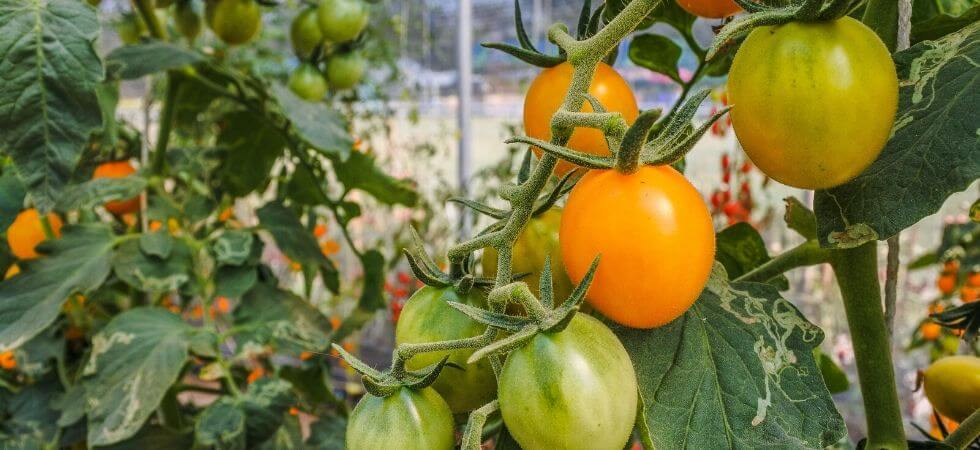
Before you transplant your tomato seedlings in your greenhouse raised bed, I will highly recommend running a rototiller inside your Greenhouse Tomato beds. This will decompress, aerate the soil and it will also help in weeds control.
I will also recommend using a Ground Cover fabric (weed control fabric) for your tomato beds. The ground cover fabric will not all any weeds to grow inside your Greenhouse Tomatoes raised bed. You should definitely install a trickle or drip system so that water can be supplied to your greenhouse tomatoes ad per requirement.
You might have seen many gardeners use organic mulch materials for weed control. The work great outside and also helps to keep the humidity high. But you should never use organic mulches inside your greenhouse because the environment inside the greenhouse is humid and it may serve as a habitat for both fungi and insects.
On the other hand, Soilless greenhouse tomatoes systems don’t require any weed control because these systems itself prevent weed growth.
I would recommend using “DeWitt Sunbelt” ground cover fabric. Unlike other plastic fabric, This one is actually a woven plastic fabric. The good thing about this fabric is that not only it will prevent the weeds from going inside your Greenhouse Tomatoes raised bed but I will also allow water to pass through the fabric and it also doesn’t block the oxygen to get into the soil like other cheap plastic film fabrics. Here is a nice video on How the Ground cover fabric helps in weed control.
The amount of water required for your Greenhouse Tomato plants will vary depending on the season and size of the greenhouse tomatoes. A small tomato seedling that has just been transplanted in your greenhouse will require only 2 ounces (50 ml) of water per day, whereas, a mature plant may need up to 3 quarters (2.7 liters) of water per day. Generally, 2 quarters of water per day is adequate for a fully grown tomato plant.
I will recommend that you monitor your plants closely for the first couple of days after transplanting so the volume of the water can be increased as needed.
I would highly recommend irrigating your greenhouse tomatoes automatically using timers clock and electronic controllers, except if you are growing greenhouse tomatoes as a hobby and you are just producing for your family. Even if you are just a greenhouse hobbyist, I would highly recommend using a drip irrigation system for your greenhouse tomatoes raised beds because it will save you a lot of time).
Here is one a cool video on installing a drip irrigation system to the raised bed, I am sharing it here with us just to give you an idea on,
With each watering, you can also provide your greenhouse tomatoes with dissolved fertilizer. This process is more specifically termed as fertigation.
If you want to see your greenhouse tomato beds to provide a plentiful supply of fresh and juicy tomato crops. To achieve the target you need to water little and often and feed tomatoes with a general liquid and high potash feed. Feed plant with it to facilitate more fruits and flowers.
Finally, I want to mention that you should water your tomato plants in such a way that water is supplied to the base of the plant rather than through overhead sprinkler systems. This keeps water off the foliage and reduces the potential for fungal diseases such as botrytis or leaf mold, which can devastate crop yields. Trickle and drip system will not only save your plants from disease but will also save a lot of labor and water.
If the medium in which you have grown your Greenhouse Tomatoes has good drainage, like rice hulls, its good to water it 10 or more time per day using drip irrigating system (This will keep the plants from drying out in between consecutive watering sessions). If your growing medium is pine bark then 5 to 10 waterings per day is quite good.
Greenhouse Tomatoes are watered enough to prevent wilting. If you keep your Greenhouse Tomatoes unwatered for a prolonged period of time then it might result in permanent wilting.
You should water your Greenhouse Tomatoes enough so that you can easily observe around 10- 20 percent of the water draining out.
Finally, I want to mention one more thing, If it’s sunny after a prolonged period of cloudy weather then your Greenhouse Tomatoes may undergo severe wilting. You should be ready to increase the amount of water.
It is a good practice to check the PH of your nutrient solution daily. If it is not possible for you then at least check the PH of your greenhouse tomatoes every time you prepare the fertilizer solution. I would highly recommend you to buy a pocket pH meter, it will be very handy. The optimum pH range for Greenhouse Tomatoes is 5.6 to 5.8.
If the pH of the nutrient solution is too high (because of the alkaline water) you should add a small amount of acid to lower the pH.
To decrease the pH of the soil you can use Nitric Acid (HNO3), Sulphuric Acid (H2SO4) or phosphoric acid (H3PO4). Sulphuric acid is cheap and easily available at battery stores however it doesn’t supply nutrients to the plants.
On the other hand, I would strongly recommend you to use Nitric Acid or Phosphoric Acid because they supply nutrients in addition to lowering the pH. Nitric Acid supplies Nitrogen to the plants whereas Phosphoric acid supplies phosphorus to the plants.
Finally, I will say that be very careful while you are handling acids because they can cause injury and add the acid gradually while monitoring the pH of the solution. (Keep track of the pH after each drop of the acid).
If the pH of the solution is too low you should add materials like caustic soda, potassium hydroxide, sodium bicarbonate, potassium bicarbonate, etc. I will strongly recommend you use potassium bicarbonate because it will supply potassium (has pH of 8.2) to your plants.
You should clean the irrigation pipes and emitters after each crop, You should use acid mixed water adjusted to a pH of 4.5. Also, tap the emitters with your hand while the acidic water is running through the emitters to break up any crust that has formed.
Might be thinking, What are transplant (seedling) tomatoes? Folks, these are short, stocky tomato plants with dark green color and straight, sturdy stems about the size of a pencil.
You can grow your tomato seedlings from seeds or you can buy the tomato seedlings from nurseries and plant them into the greenhouse tomatoes beds.
One thing to keep in mind is to avoid buying and using tomato transplants with flowers or fruits in progress before you plant them inside the greenhouse bed. Avoid seedlings with spots, stress damage or leaves turning yellow in color.
The first step in growing your Greenhouse Tomato seedlings is the selection of the methods by which you will propagate your seeds. These methods are.
Majority of the Greenhouse enthusiasts are adopting growing in plug Trays (I recommend 50 Cell Plug Trays). Plug Trays have cup holes (cavities) that need to be filled with a growing medium for the seeds to germinate and develop some root ball. Greenhouse growers love them because the seedlings grown in these trays undergo minimum root damage and transplanting shock (when the seedling is pulled for transplanting). Greenhouse tomatoes transplanted from plug trays usually have a 100% establishment rate. I strongly recommend using plug trays for growing your tomato seedling.
The individual cell of these trays has a hole in the base for draining excess water. Before using Plug Trays they should be fully cleaned and expose to sunlight or disinfected with 1% solution of chlorine bleach. This is done to kill fungus on these trays, if any.
These trays are just like normal trays with elevated edges and they also have drainage holes in the bottom. They are filled with the growing medium and the seeds are dispersed on the medium. Sowing seeds in these trays are easy and less labor-intensive however while transplanting the roots of the tomato seedlings might be entangled and the seedlings might undergo root damage while transplanting. I will not recommend it!
Seedlings are raised in beds when large quantities of seedlings are needed and the aforementioned methods are not available. However, seedlings may suffer from root damage when the plants are pulled out of the seedbeds for transplanting. Damage to the roots will delay growth or cause the seedlings to die. Not recommended!
You will have to fill your plug trays with a growing medium (make sure that it should have good drainage). I will highly recommend using preprepared Commercial Potting Soil because it will ensure the healthy growth of your plants without worrying about weeds or disease.
If you want to prepare the potting soil yourself then you should mix garden soil, sand, well-decomposed compost, and rice hulls in a 1:1:1:1 ratio. Another good growing medium recipe is a mixture of decomposed cocodust, cow dung, and soil in a 2:1:1 ratio.
You should fill the growing media in the plug trays and then give the tray a few taps on the ground to remove any of the air pockets. You should then sow 1 seed per cell (I don’t recommend adding 2 or more seeds per cell because you will have to prune one anyways. Only do it when your seeds are old because old seeds have low germination rate ). Push the seed about 2 mm into the ground using a toothpick and cover it will a layer of growing media.
Keep the growing media moist but not saturated. Depending upon the fertilizer supplied with the growing media (the compost which you have added), it may be necessary to provide low levels of fertilizer during the growing stage. Dissolve about six ounces of water-soluble 20-20-20 fertilizer into 100 gallons of water and feed it to your seedlings.
Note: It is always a good idea to maintain a good ratio of organic fertilizer (decomposed compost) in your seedling growing media rather than relying on chemical fertilizer because if you mess up by adding an excess amount of chemical fertilizer to your tomato seedling you may burn them to death.
When you have sown the seed, the first watering should be intense. Water your greenhouse tomato seeds enough so that there is drainage from the tray. After that water your seedling only to keep the growing medium moist. You should never let the medium dry out because it will seriously damage your greenhouse tomato seedlings.
Sprinkle seedlings with water daily in hot and dry weather or once every two days in cool weather to provide sufficient moisture for growth. Overwatering tomato seedlings are common in cool weather. Lift a few seedlings from the plug trays to test whether they feel too heavy (waterlogged) or too light (under-watered), and adjust watering if necessary.
If your growing medium is getting dry quickly then I will recommend putting your seedling plug tray in a bigger tray with a transparent lid (I recommend using Super Sprouter Germination kit, it also has a heating pad for fast germination). This will act as a little greenhouse and will keep the humidity high and the growing medium will not dry out quickly. One thing I want to mention is that this system will also help your tomato seeds to germinate faster because of high humidity.
Remember not to overwater seed pots when you are asked to keep the compost moist. Overwatering and keeping the compost moist are two different things. Be careful! Overwatering causes molds to grow inside your greenhouse bed and facilitates damping-off disease. We probably don’t want this.
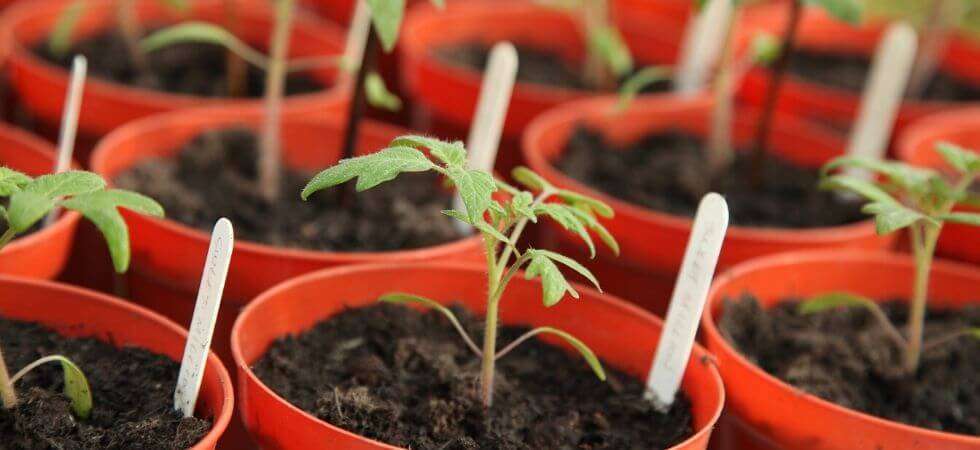
Plants grown in the “plug trays” need to be hardened for a few days before they are transplanted to the greenhouse. Plants can be easily hardened by removing them from the germination greenhouse about one week prior to the expected transplant date. They can be held in partial shade inside your greenhouse for a day or two, then moved to full sun with appropriate watering as necessary.
Your tomato seedlings will be ready to be transplanted into your greenhouse beds when they have the following features.
Here is a nice instructional video from YouTube channel “Project Diaries”on how you can grow your tomato seedlings from seeds. He is then transplanting the seedlings in his garden raised bed however we are growing seedlings inside our greenhouse.
If you want to have an ideal greenhouse border soil which will provide your crop plants with nutrients and retain water without been waterlog. So all you need to do is dig out the existing soil about a spade depth or more. With a fork break up the sub-soil at the bottom. After layering the soil, add in 6″ or a more, thick layer compost, also add an ounce (28 g) per square foot of wood ash. Also, add a small amount of bone meal (for calcium enrichment).
This is another very important issue to deal with, so inside the greenhouse border soil, we mostly come across pests like slugs and snails. You can get rid of these two pests by using beer traps or safe slug pellets. I would recommend you to use Garden safe brand slug and snail bait granules. These granules are made up of iron and phosphate combination, which is a plant nutrient that occurs in soils, with snail and slug bait additives.
When snails and slugs eat these bait, their feeding habit stops completely, they become less mobile and eventually die with 3 to 6 days. Please do not use dilute Jeyes Fluid because it will kill all the microbes and worms along with the disease. Which is not good at all.
Now transplant these 12 to 15cm tall young tomato plants into your greenhouse raised bed with 2 feet separation between in individual tomato plants and rinse it with water. Ventilate the greenhouse on a daily basis to avoid pests and diseases.
Here is a cool video from “Spring Hill farms” on transplanting Tomato seedlings in greenhouse tomatoes bed.
Grow bag is a bag made out of plastic which is filled with a growing medium (compost) and is used for growing vegetable crops. There are many brands and sizes of grow bags that can you buy. I recommend using EACHON Growbag.
I would recommend using 50% topsoil along with 50% percent compost. Fill the grow bag with this compost mixture so that you know how much mixture is needed. Take out the mixture and mix 2 tablespoons of organic fertilizer with it. Also, add a half tablespoon of bone meal (for calcium enrichment). You can also add a small amount of Epsom salt.
Mix the mixture (media) well, fill the grow bag with this media and then pot your tomato seedlings into the grow bag.
Here is a cool video (by Youtube channel: The Millennial Gardener) on how you can use Growbags for growing tomatoes.
However, If you prefer growing in pots rather than grow bags then you might be thinking What size pots to use for growing tomatoes? The pot size should be 20cm (10″), capacity to hold 10 liters of compost. You can use 30cm (12″) square planters which are a better choice as they hold around 25 liters of compost and hold more water. These 12″ square planter will lower the drawbacks we face like compost drying out in few hours, with smaller size planters which have limited water retention capacity.
As we have discussed before there are 2 types of tomatoes, determinate (growth stops at 4-5 feet) and indeterminate (keeps growing). For determinate tomato varieties, very little to no pruning is required. On the other hand for indeterminate tomato varieties, extensive pruning is required.
Pruning is very important (especially for indeterminate tomato varieties), if you want to have a good size and high-quality fruits. But You should always prune your tomato plants to a single stem by removing all of the later shoots also known as suckers.
From where do these suckers emerge?
Well! Above every leaf node on the tomatoes stem, a sucker (side shoot) can emerge (Yes, these suckers can produce tomatoes). If you allow suckers on your tomato plant, the plant will produce more fruit, However, the size of the tomatoes will be small and the tomatoes will be of low quality.
It is best to allow just one main stem of the tomato plants. This will result in large uniform size tomatoes that will be of high quality.
Don’t remove all of the suckers at once, allow 1 or 2 small suckers at the top of the tomato plant. This is because the top end of the tomato plant is very delicate and can be easily damaged. So if the main (terminal) stem breaks off then the sucker can take over and become the terminal stem.
Basically, it is the practice of training tomatoes to rely on the support which is important to ensure the healthy growth of your greenhouse tomato plants. When tomatoes start growing to length, they need support which is done in two ways the string support and the other one is a pole or cane support. Let us see how these methods support our growing tomatoes. Note: Training is very important for indeterminate tomatoes because they keep on growing taller and taller.
Exactly, when is the time to support your Greenhouse Tomatoes? Well, when the tomato plant reaches a height of 45cm (18″) and it is expected to drop because of the weight of tomato fruits. To keep your greenhouse tomatoes in the upright position you will have to support it either with a string or cane.
How to String Support Greenhouse Tomatoes? It has long been practiced to support cordon/ indeterminate tomatoes on a string. The string is anchored at the base of the tomato plant in the greenhouse tomato bed and attached to the support line at the top.
Run wire support along the length of your greenhouse tomatoes. The support should be 8-10 feet above your tomatoes plant. You should always use galvanized wire and the wire should be 9-gauge (The Hillman Galvanized wire) or 3/32-inch in diameter.
Tie one end of the string to the bottom of the plant and tie the other end of the string to the support wire. I would recommend using Plastic Clips for stringing the stem of the tomato plant to the wire.
If you don’t want to use the Plastic Clips for supporting the greenhouse tomato plants you can just wrap the stem of the plant around the wire in the clockwise or counterclockwise direction. (However, I prefer clips).
If the greenhouse tomato plant reached the top of the support you can lean the plant over the support so that it can then hang from the support.
The use of the bamboo cane as a method for supporting cordon tomatoes is quite interesting. How to make use of it? Insert a bamboo cane by the tomato plant and tie the stem to the cane as it grows. You can use a figure of eight with the string so the tomato stem has room to expand as it grows.
It is advised to grow cordon at an angle rather than vertical, this is practiced by commercial growers. Those guys know what they’re doing and if you have the room it may increase yield – although home growers are looking at just 5 to 7 trusses, not the 25 + trusses as for commercial growers.
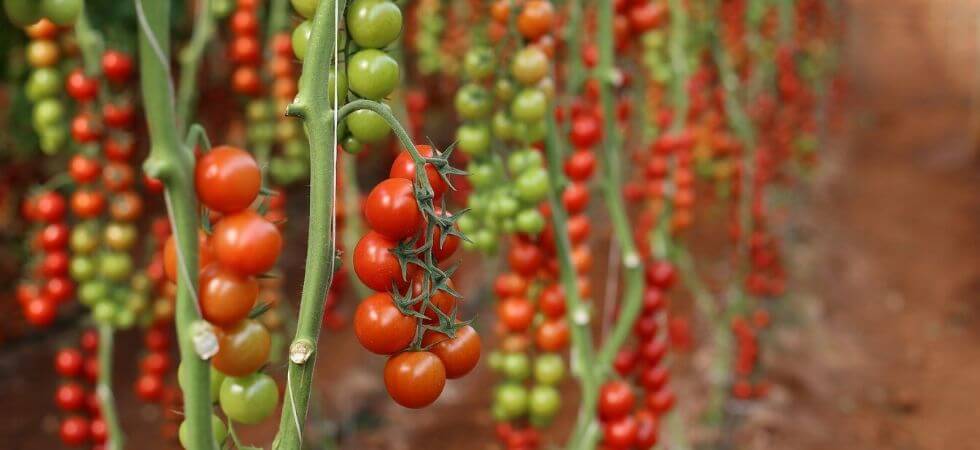
Tomato plants doest require pollinating if you are growing it outside in the fields because the winds and other insects do this job for you. However, pollinating inside the greenhouse is highly required and if you skip pollinating your greenhouse tomatoes then there will be a reduction in the number of fruit set per plant. You should always pollinate the female flower part of your greenhouse tomato plants before the fruits will set.
Beside reduction in the number of fruit-set per plant, poor pollination can raise several problems.
Furthermore, Pollination can prevented by the following stress factors.
The amazing thing about tomato flowers is that they have both male and female parts within the same flower. Such flowers Botanically are termed as perfect flowers. Hence, In the fields, tomato flowers are mostly pollinated by winds rather than bees and other insects.
Most of the tomato flowers pollen fertilizes the ovary withing the same flowers, Some pollen from one flower might also react to another flower through winds.
However, in a greenhouse, the wind is not enough to pollenate tomato flowers. Therefore you have to take the task of pollinating your greenhouse tomatoes.
The optimum temperature for tomatoes pollination is 70°F (21°C) to 80°F (26.7°C) and the relative humidity is 70%.
However, if the relative humidity is above 80% the pollen grains stick together and do not disperse well.
On the other hand, if the relative humidity is less than 60% for a long period of time, the stigma may dry out and the pollen will not stick to the stigma well.
Furthermore, fertilization occurs after 48 hours after pollination.
I would highly recommend using an electric pollinator if you have a small greenhouse. These pollinators are normally powered with disposable alkaline batteries or rechargeable batteries. I am using an electric pollinator using AA cell for my greenhouse tomatoes ( AeroGarden Pollinator ).
Its good to recharge battery after each pollination session so that it is ready for the next session.
If you don’t want to spend money on buying a dedicated electric pollinator for your greenhouse tomatoes then you can just use your electric toothbrush for this purpose. Check out this video from the channel “Self Sufficient Me” where he uses an electric toothbrush to pollinate his tomato plants.
You should vibrate each flower cluster for about 1-2 seconds (touch the wand to the flower stem). Never touch the vibrator to the individual flowers because they will be damaged and as a result, the end fruit will also be damaged.
What if you have a large greenhouse with lots and lots of tomato plants? You should purchase bumble beehives for your greenhouse tomatoes. They will do the task of pollination for you. You can purchase bumblebee hives from commercial suppliers.
Generally, one hive lasts for about 8 weeks and then you will have to replace it with a new hive. You should introduce beehives when almost 50 percent of the tomato plants have flowered. Before that, I would strongly recommend using an electric pollinator.
You should pollinate your Greenhouse Tomatoes every other day or you can also pollinate your greenhouse tomato flowers 3 times per week.
Never, leave 2 days or more days in between two consecutive pollination sessions because it might reduce the fruit set. I would also suggest not to pollinate every day (it has no harm actually) because it will waste a lot of your time.
Yes, it matters. You should always pollinate your greenhouse tomatoes when the relative humidity level of your greenhouse is between 60-70 %. For Example, if you are living in an area of high humidity find the time when the humidity level of your greenhouse is at its daily minimum and pollinate your Greenhouse Tomatoes at that time.
If the amount of moisture in the air stays constant, then the humidity level of the greenhouse will drop as the temperature of the greenhouse rises (This is due to the fact that warm air can hold more moisture than cold air). So at mid-day, the humidity of the greenhouse will be at the lowest point and it would be best if the Greenhouse Tomatoes are pollinated at this time.
The easiest and effective way of determining the best time for pollinating your greenhouse tomatoes is by buying a cheap humidity meter. Just follow the trend of the humidity change for a week and then choose a time when the humidity levels inside your greenhouse are between 60-70 percent.
Actually, you can easily witness if the pollination is happening or not. When you vibrate the stem of your greenhouse tomato plants you will see a small cloud of yellow powder dispersed around the flower.
This yellow power is actually the pollen and this process will clearly ensure that the pollination has occurred.
Cloudy weather negatively affects the process of pollination. Actually, in cloudy weather the relative humidity is high and the pollen instead of dispersing as individual grain tends to stick together in clumps which negatively impacts the process of pollination.
Even if it is a cloudy day, don’t skip pollinating your greenhouse tomatoes and stay with your pollination schedule.
Well, definitely this will affect the process of pollination and as a result you will get a low fruit set. Which is bad!
But, you can compensate for this by decreasing the humidity level of your greenhouse (by drying out the air). You should dry the air by turning on the heating system for 30 to 60 minutes before pollinating your greenhouse tomatoes.
You can compensate for the heat produced during the heating by ventilating the air out, so the temperature of your greenhouse will remain constant.
If you want to have good yield from your Greenhouse tomato plants, then, Yes! An electrical Pollinator is necessary for your greenhouse tomatoes.
According to the research conducted by the University of Southwestern Louisiana Center of Greenhouse Research, it is found that Skipping on electric pollinator will decrease Greenhouse Tomatoes yield by 21%.
I would definitely recommend spending some money on a good electrical pollinator.
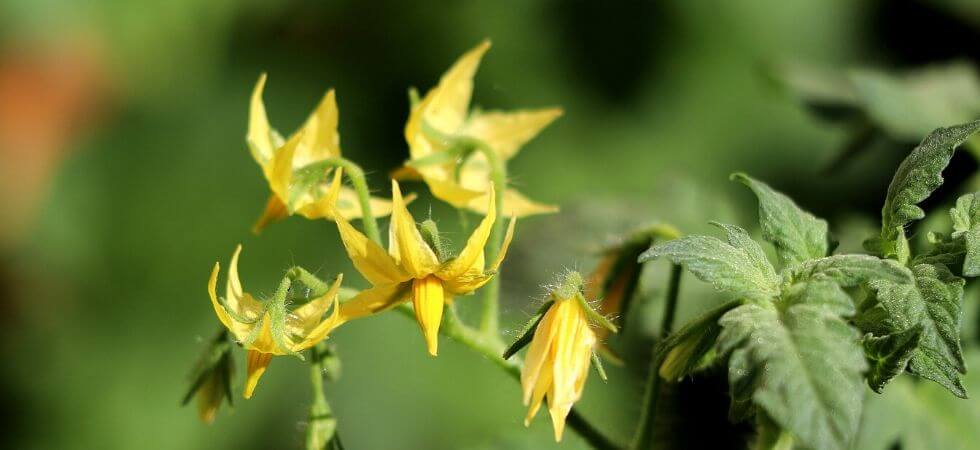
Ventilation helps in drying the tomato foliage and reducing disease problems, as well as improving pollen shed due to lower humidity in the greenhouse, compared to poor ventilation and high humidity. Experiments have shown that keeping the foliage as dry as possible with sufficient air movement to enhance pollen shedding has more than doubled per-plant yields. Due to these factors, spring production is practiced more widely than fall production.
However, there are more serious problems in obtaining a profitable yield during winter. Low outdoor temperatures make it highly improbable to provide good ventilation to control humidity. Under such conditions, leaf mold usually becomes a major problem. Flowering and fruit set are reduced, which results in low yields per plant. Low light intensity reduces fertilizer uptake, resulting in reduced fruit size and visual fertilizer deficiency symptoms on the foliage. Heat costs increase due to lower temperatures, resulting in higher production costs. In general, producing during the winter has not proven to be profitable due to high fuel costs and low yields.
When is the perfect time to pick tomatoes? The perfect time to pick tomatoes from the greenhouse border bed is when they gain red color and are firm. Do not go for the size of the fruit if it’s red and firm, then pick it out. You need to have some patience and wait till the tomato turns complete red. Do not pick out orange and yellow tomato fruits.
Place tomatoes in a paper bag with the stem up, if any fall off before they appear ripe. Store them in a dark and cool place. Note: Avoid placing tomatoes on sunny windows to ripen. Why? Because by doing so they will rot before they are ripe. So we do not want that to happen.
It is very easy to store the tomatoes in the refrigerator. Please do not refrigerate fresh tomatoes. Refrigeration will destroy the flavor and texture that make up that greenhouse tomato taste. All that 6 months of hard work will go in vain.
So, to freeze, these freshly harvested and not damaged tomatoes. You need to place them whole in the freezer bags or containers. By the time you use them, they will defrost and the skin will slip off.
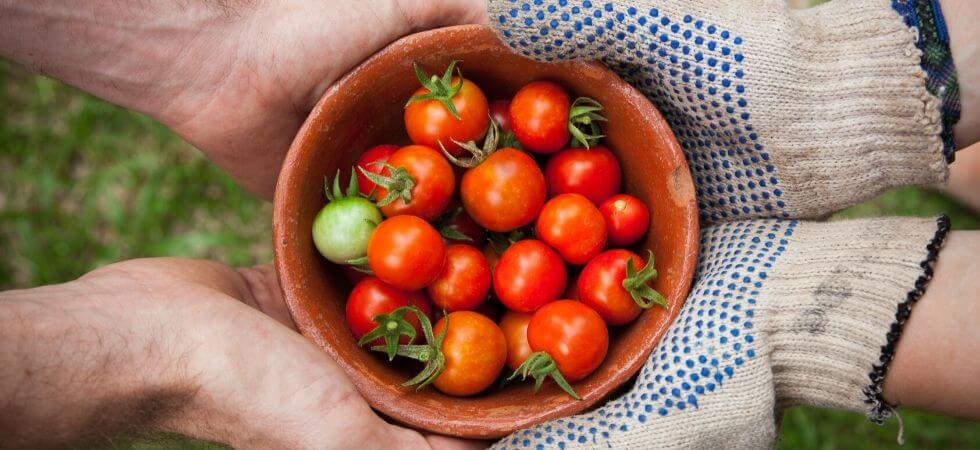
Like other crop plants, tomato plants do get affected by insect pests, irregular watering and sometimes wet environment of the greenhouse. The first problem a tomato plant face is the tomato blight.
What is Tomato blight? It is a family of diseases caused by fungus-like organisms that spread through tomato foliage, particularly during wet weather. What it does is it spreads quickly, causing leaves to discolor (brown patches), rot the fruits, kills the vines, and collapse the tomato plant. How to stop Tomato blight? Either use spray: Bordeaux Mixture on your plants early in the summer. Another best way is to reduce humidity in the greenhouse by moving air and venting moisture, provide adequate spacing between plants and have well-drainage floors all these practices will reduce humidity and the fungal growth.
The only solution to the fruiting problem is regular watering not too much not too little or late. Water evenly a regularly to the base of the tomato plant.
Sunlight can also damage your tomato plant. No doubt tomatoes are sun lovers but too much light intensity causes it to blotch, scales, or spots on the growing fruit. Due to the high light intensity tomato plant goes through a condition called Greenback. Greenback causes a hard green area on the ripe fruit shoulder. How can you reduce this problem? Use fleece or shading as a cover, during the hottest part of the day or increase the potassium supply.
Green and Whiteflies cause damage to tomato plant to avoid these pests grow companion plants like marigolds with tomato plants. Marigold attracts beneficial insects that feed of green and whitefly. You can use organic ways to control pests and diseases and you can also take the help of the beneficial insects to eradicate the pests.
The yellowing and curling of tomato leaves are caused by magnesium deficiency and aphids sucking the sap from leaves. The yellowing of tomato leaves can be stopped by feeding the plants with magnesium feed. Aphids can be dealt with by introducing beneficial insects into the greenhouse. If the curling of leaves is not caused by aphids then it is cold nighttime temperatures. If you see mosaic pattern leaf surfaces, it is due to a virus, just don’t panic, remove and destroy them before the problem spreads to nearby plants. It is highly recommended to disinfect gloves, boots, and tools with which you dealt with the infected plants. To avoid the rest of the plants to catch the disease.
Many disorders and diseases that are found in the greenhouse tomatoes are due to the environmental stress on your Greenhouse include. These include stress due to temperature, humidity, nutritions sunlight, and watering.
We have listed the most common physiological disorders of Greenhouse Tomatoes.
These are the cracks that radiate near the stem end of the tomatoes and proceed downwards. These cracks may arise in your greenhouse tomatoes due to the following articles.
These are the circular cracks that are formed around the stem end of the tomatoes. These cracks are also caused by water problems. The following are the reasons for these cracks.
Splitting in greenhouse tomatoes occurs due to temperature stress. Greenhouse tomatoes split skin when exposed to high temperatures. You can prevent this by lowering the temperature of your greenhouse (INCLUDE A LINK ON HOW TO DO IT).
Cat facing occurs when the tomato plants are exposed to very high or low temperatures during the fruit set or any disturbance to the flowers.
These disorders include scarring, malformation, or cracking of fruits at the blossom end. Sometimes it may even leave holes in the fruit.
Greenhouse Tomatoes may form brownish or grey areas on green fruit due to Blotchy Ripening (also called as “Gray Wall”). As Greenhouse Tomato matures and turns red these areas may remain grey or turn red causing uneven ripening. It is hard to identify the cause of this defect. This defect might arise due to
In this disorder the top end (the stem end ) of the tomatoes remains dark green even if the tomato is fully ripe. Sometime this area may turn yellow while the remainder of the tomato is dark red.
This disorder arises due to high light and high temperature conditions. Adequate ventilation, proper shading system and adequate phosphorus and potassium fertility can be used to combat this disorder.
In this disorder the bottom end (blossom end) of the greenhouse tomatoes become brown, light tan or black.
This disorder is due to calcium deficiency. Sometimes the amount of calcium in the soil or in the nutrients solution is adequate but it is unable to reach the plants due to less watering.
To prevent blossom end rot make sure that your plants have adequate calcium supply and avoid wide fluctuations in temperature and water.
Greenhouse tomatoes become puffy, which means that they have an angular appearance with one side flatter than the others. Such Greenhouse Tomatoes are also weightless and they do have much juice in it.
Puffins occur in Greenhouse Tomatoes due to poor pollination, which is caused by the following environmental problems.
To solve the issue of Puffins try to maintain your greenhouse temperature and adequately watering your greenhouse tomatoes.
Decrease the nitrogen level in your nutrient solution and the soil.
Make sure to pollinate every other day using an electric pollinator.
In this disorder, yellow and whitish patches appear on the side of the tomato facing the sun. This is actually “sunburn” and it is caused because the tomato is suddenly exposed to the sun after it was under the shade, especially during hot and dry weather.
I hope you loved this article and now you are confident in growing your greenhouse tomatoes. I have prepared this pin for you so that you can save it to your Pinterest so you can always come back and refresh your ideas on growing Greenhouse Tomatoes.
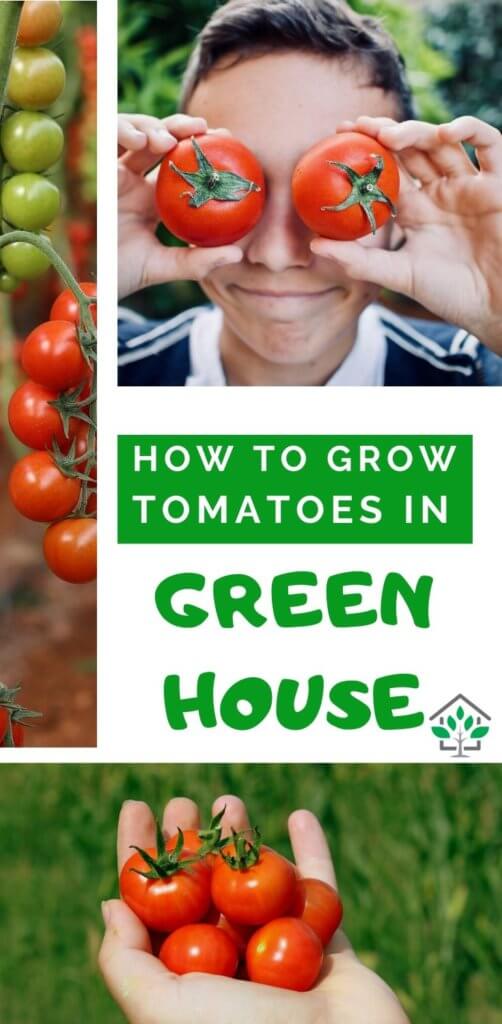
Comments are closed.
[…] […]
will the soil not run out of vital nutrients if one continues to farm the same land year in and year out.
Kindly give an indication of associated cost in this type of farm . This will include the capital cost and operational cost for an acre of greenhouse tomato farming.
What will be the profit margin from such a venture as one is thinking of going into this sort of farming for commercial purposes that is money making.
Can training be provided or the training offered by professionals to manage the farm for maximum yield leading to good profit.